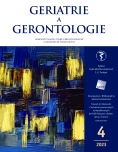The role of the doctor in cases of domestic violence against the elderly
Authors:
Bretšnajdrová Milena 1; Špatenková Naděžda 2; Ivanová Kateřina 3; Polzerová Zdenka 2
Authors‘ workplace:
II. interní klinika – gastroenterologická a geriatrická, Lékařská fakulta Univerzity Palackého a Fakultní nemocnice Olomouc
1; Odborný léčebný ústav Paseka u Šternberka
2; Ústav veřejného zdravotnictví, Lekařská fakulta Univerzity Palackého Olomouc
3
Published in:
Geriatrie a Gerontologie 2023, 12, č. 4: 164-167
Category:
Review Article
Overview
More than 80% of care for the elderly dependent on the help of others is provided by families, while the average period of providing this type of care is 4 to 5 years. As a relatively closed social system, families represent a risky environment regarding the possible development of violent behavior. Such maltreatment of the elderly may result in an injury requiring outpatient treatment or hospitalization, and in extreme cases, it can even lead to the death of the elderly.
The aim of the study is to provide doctors with essential information on the issue of domestic violence against the elderly and thus support their alertness for detecting the basic signs of domestic violence. Doctors should be able to identify domestic violence based on the given indicators and be aware of the specifics of the elderly as persons at risk of domestic violence.
We present case studies and presentations of possible interventions in the case of domestic violence against the elderly.
Domestic violence against the elderly is a serious societal problem. The optimal solution in the case of domestic violence is to get the patient in contact with the intervention center services, which play an irreplaceable role in the system of support to persons at risk of domestic violence.
Sources
1. Ivanová K, Špatenková N, Bužgová, R. Rizikoví senioři – sociální fenomén demografického stárnutí populace (Ochrana zájmů křehkých a nekompetentních seniorů). In: Ryšavý D. (ed.). Sociologica – Andragogica. Olomouc: UP 2010 : 67–78.
2. Ševčík D, Špatenková N, a kol. Domácí násilí. Kontext, dynamika a intervence. Praha: Portál 2011.
3. Nerengerg L. Elder abuse prevention: Emerging trends and promising strategies. New York: Springer Publishing Company 2008.
4. Špatenková N. Domácí násilí. Opava: SLU 2022.
5. ČSÚ. Senioři v ČR v datech. Praha: Český statistický úřad 2022.
6. WHO, Health care for women subjected to intimate partner violence or sexual violence. A clinical handbook. Geneva, Switzerland 2013. www.who.int.
7. Durdík T. Domácí násilí a jiné formy týrání páchaného na starších osobách v soudobé české společnosti z pohledu trestního práva. Prevence se musí vyplatit. Ministerstvo vnitra České republiky 2013.
8. Kalvach Z, a kol. Geriatrické syndromy a geriatrický pacient. Praha: Grada Publishing 2008.
9. Knight L, Hester M. Domestic violence and mental health in older adults. Int Rev Psychiatry 2016; 28 (5): 464–474.
10. Yin RK. Case study research. Design and methods. London: Sage Publications 2009.
11. Olecká I, Ivanová K. Případová studie jako výzkumná metoda ve vědách o člověku. Metodologie výzkumné práce. Olomouc: MVŠO 2010.
12. Gorbien MJ, Eisenstein AR. Elder abuse and neglect: an overview. Clin Geriatr Med 2005; 21 (2): 279–292.
13. Marvánová-Vargová B, Horák L, Pekara J. Intervence v případech domácího násilí. Manuál pro zdravotníky. Praha: ROSA 2016.
14. Atkinson E, Roberto KA. Global approaches to primary, secondary, and tertiary elder abuse prevention: a scoping review. Trauma Violence Abuse 2023 : 25(1):150-165.
15. Vaničková E, a kol. Domácí a genderově podmíněné násilí. Manuál pro lékaře. Praha: UK 2017.
16. Pritchard J. The abuse of older people: a training manual for detection and prevention. London: Jessica Kingsley Publishers 1995.
Labels
Geriatrics General practitioner for adults Orthopaedic prostheticsArticle was published in
Geriatrics and Gerontology

2023 Issue 4
Most read in this issue
- Gerontological prevention as part of geriatrics
- News
- Hearing loss – with an emphasis on presbyacusis and its solution
- Myasthenia gravis in a geriatric patient
